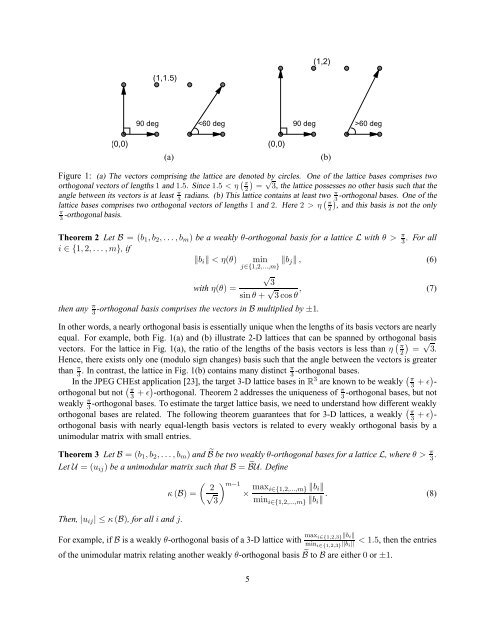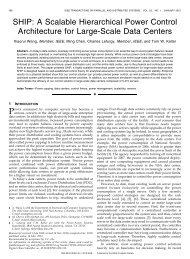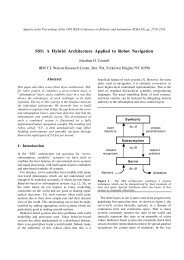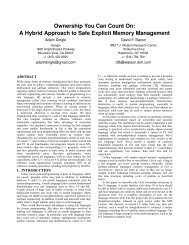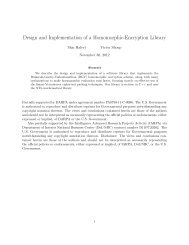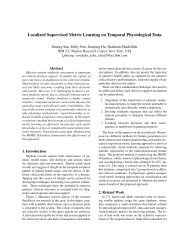On Nearly Orthogonal Lattice Bases and ... - Researcher - IBM
On Nearly Orthogonal Lattice Bases and ... - Researcher - IBM
On Nearly Orthogonal Lattice Bases and ... - Researcher - IBM
You also want an ePaper? Increase the reach of your titles
YUMPU automatically turns print PDFs into web optimized ePapers that Google loves.
(1,2)(1,1.5)90 deg60 deg(0,0)(a)(0,0)(b)Figure 1: (a) The vectors comprising the lattice are denoted by circles. <strong>On</strong>e of the lattice bases comprises twoorthogonal vectors of lengths 1 <strong>and</strong> 1.5. Since 1.5 < η ( ) √π2 = 3, the lattice possesses no other basis such that theangle between its vectors is at least π 3 radians. (b) This lattice contains at least two π 3-orthogonal bases. <strong>On</strong>e of thelattice bases comprises two orthogonal vectors of lengths 1 <strong>and</strong> 2. Here 2 > η ( )π2 , <strong>and</strong> this basis is not the only-orthogonal basis.π3Theorem 2 Let B = (b 1 ,b 2 ,... ,b m ) be a weakly θ-orthogonal basis for a lattice L with θ > π 3. For alli ∈ {1,2,... ,m}, if‖b i ‖ < η(θ) min ‖b j‖ , (6)j∈{1,2,...,m}√3with η(θ) =sin θ + √ 3 cos θ , (7)then any π 3-orthogonal basis comprises the vectors in B multiplied by ±1.In other words, a nearly orthogonal basis is essentially unique when the lengths of its basis vectors are nearlyequal. For example, both Fig. 1(a) <strong>and</strong> (b) illustrate 2-D lattices that can be spanned by orthogonal basisvectors. For the lattice in Fig. 1(a), the ratio of the lengths of the basis vectors is less than η ( √π2)= 3.Hence, there exists only one (modulo sign changes) basis such that the angle between the vectors is greaterthan π 3 . In contrast, the lattice in Fig. 1(b) contains many distinct π 3-orthogonal bases.In the JPEG CHEst application [23], the target 3-D lattice bases in R 3 are known to be weakly ( π3 + ɛ) -orthogonal but not ( π3 + ɛ) -orthogonal. Theorem 2 addresses the uniqueness of π 3-orthogonal bases, but notweakly π 3-orthogonal bases. To estimate the target lattice basis, we need to underst<strong>and</strong> how different weaklyorthogonal bases are related. The following theorem guarantees that for 3-D lattices, a weakly ( π3 + ɛ) -orthogonal basis with nearly equal-length basis vectors is related to every weakly orthogonal basis by aunimodular matrix with small entries.Theorem 3 Let B = (b 1 ,b 2 ,...,b m ) <strong>and</strong> ˜B be two weakly θ-orthogonal bases for a lattice L, where θ > π 3 .Let U = (u ij ) be a unimodular matrix such that B = ˜BU. Defineκ(B) =Then, |u ij | ≤ κ(B), for all i <strong>and</strong> j.( 2 √3) m−1× max i∈{1,2,...,m} ‖b i ‖min i∈{1,2,...,m} ‖b i ‖ . (8)For example, if B is a weakly θ-orthogonal basis of a 3-D lattice with max i∈{1,2,3}‖b i ‖min i∈{1,2,3} ‖b i ‖< 1.5, then the entriesof the unimodular matrix relating another weakly θ-orthogonal basis ˜B to B are either 0 or ±1.5


